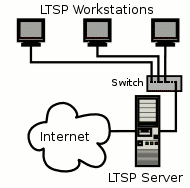
Looking to deploy Virtual Desktop Infrastructure (VDI) with Ubuntu Linux?
Virtual desktop infrastructure with Ubuntu Linux is ideal for anyone who is concerned about security of WAN based VDI. It is also perfect for organizations hosting their applications in the cloud, utilizing software-as-a-service through a web browser. VDI with Ubuntu Linux eliminates the maintenance of desktop devices, and reduces the number of hard drives in your IT footprint.
Linux Terminal Server Project (LTSP) allows the centralized deployment of virtual desktops on a local area network. Virtual desktop devices (thin clients) are connected to a switch on the LAN which connects to a server or cluster of servers delivering a desktop environment and applications.
LTSP is integrated into Ubuntu 11.04 and earlier versions. The logical choice for deployment is Ubuntu 10.04, a LTS version. LTS stands for long term support, which provides three years of security and maintenance updates.
Low Cost VDI with Ubuntu Linux
With LTSP organizations can recycle old Desktop PCs (800 MHz, 256MB RAM) or deploy new low footprint and energy efficient thin clients. A properly sized quad-core server could power up to 50 thin clients, providing desktop environments at a relatively low cost. Cost savings are most notable in maintenance and security over the years. Desktop hardware refresh cycles are between 7 and 10 years, thanks to the lack of spinning hard drive in each desktop device. Backups take place only in the server room. Desktop device replacement is as simple as drop in and power on (unless you have security customizations).
LTSP Technical Overview
Thin client devices in a virtual desktop deployment with Ubuntu Linux boot over your local area network. The virtual desktop environment and applications are executed on the server in a read only format. Users are still able to customize their desktop’s as well as access personal and shared fire storage. Applications can be delivered from local or remote application servers and can be Windows or Linux based.
Read more: Bihlman.com